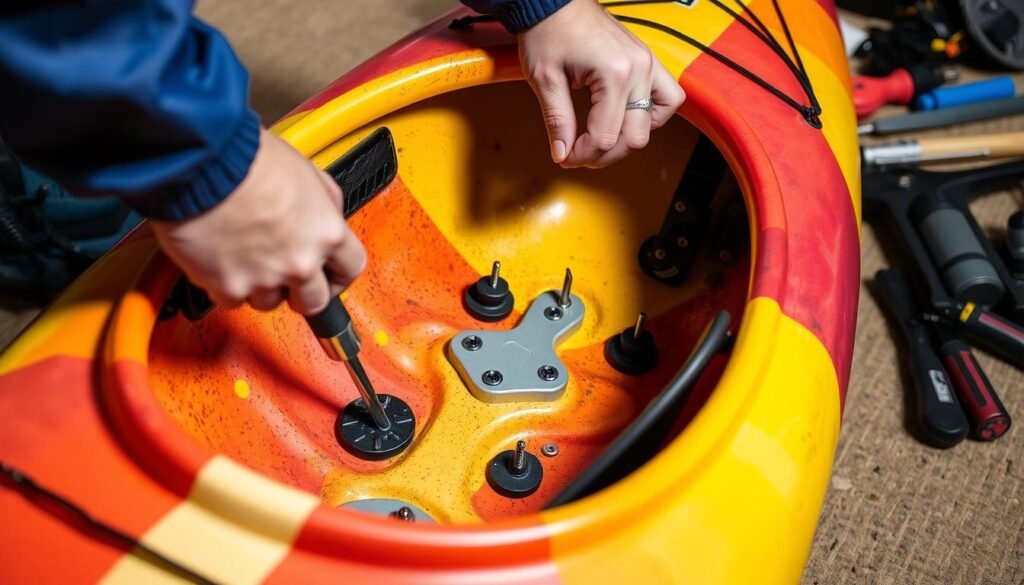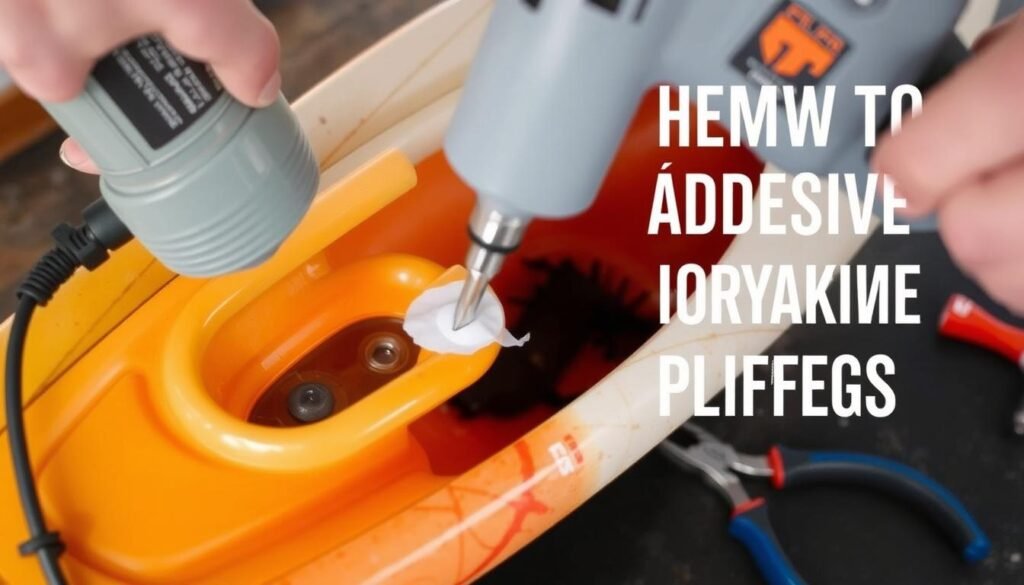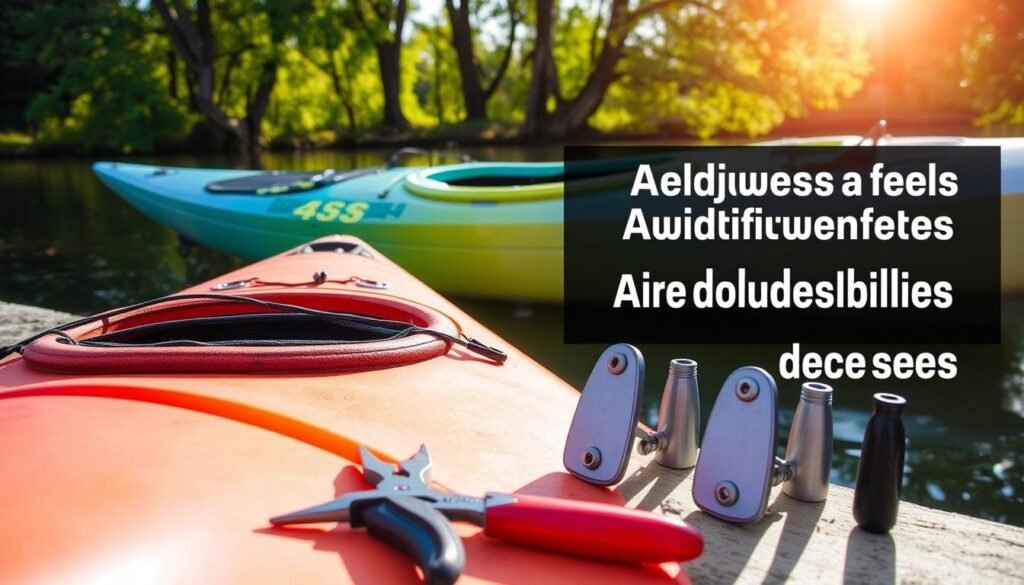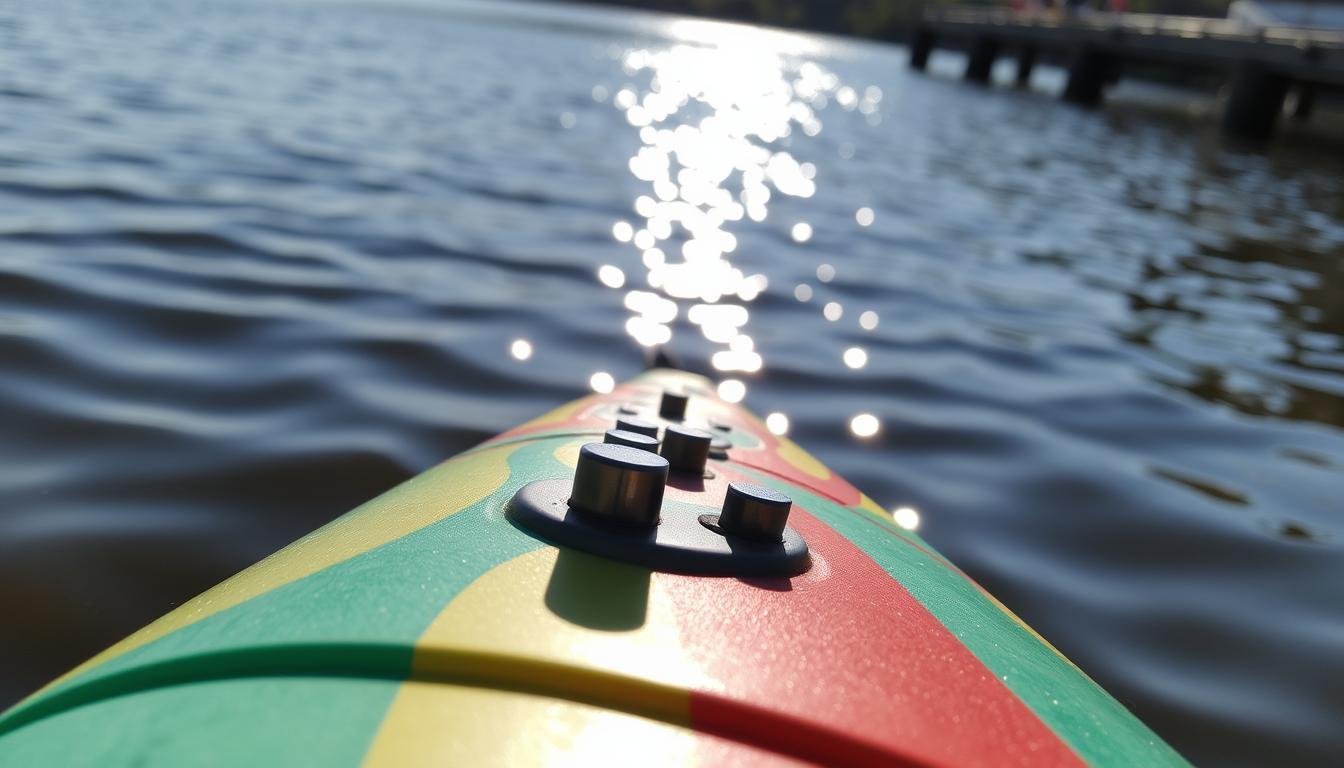Learning to safely remove fixed kayak rpegs is key for upgrades, repairs, or maintenance. Whether they’re held by screws, rivets, or adhesive, the right steps are vital. This guide will show you how to remove fixed kayak rpegs without harming your kayak, allowing you to install new rpegs that provide better support and control.
Key Takeaways
- About 90% of kayak foot braces are screwed in, while 10% are bolted from the outside.
- You’ll need a screwdriver, pliers, an Allen wrench, and silicone sealant to remove them.
- Always check the foot braces for damage before putting in new ones to avoid problems.
- Choosing the right replacement braces is key for comfort and performance.
- Use silicone sealant in all cases to keep your kayak waterproof when installing new braces.
Table of Contents
Understanding the Need for Removing Fixed Kayak Pegs
For seasoned kayakers and adventurers, keeping your kayak comfortable and efficient is key. One often overlooked part of kayak customization is removing fixed pegs. These rigid foot braces can limit your paddling experience. Let’s see why removing these pegs and using adjustable ones can make your time on the water better.
Why Removing Fixed Kayak Pegs is Essential
Fixed kayak pegs can be uncomfortable, especially for paddlers of different sizes and body types. These rigid braces don’t fit the natural shape and movement of the feet. This can cause heel soreness, sciatica, and fatigue during long trips. By removing the fixed pegs, you can enjoy more kayak comfort and adaptability to your needs.
Benefits of Adjustable Kayak Pegs
- Improved kayak customization to fit your unique body and paddling style
- Enhanced paddling efficiency by allowing for a more natural and ergonomic foot positioning
- Reduced risk of kayak-related injuries, such as heel soreness and sciatica
- Increased kayak comfort during extended paddling sessions
- Versatility in foot placement, allowing for barefoot paddling with foam padding
Switching from fixed to adjustable kayak pegs is a simple yet impactful change. It can greatly improve your on-the-water experience. By removing those rigid braces and installing customizable footrests, you’ll enjoy more kayak comfort, paddling efficiency, and fun on your next kayaking trip.
Tools Required for Removing Fixed Kayak Pegs
Keeping your kayak in top shape means removing fixed pegs sometimes. You might want to change to adjustable pegs or just update your kayak’s look. Having the right tools makes this job easier.
You’ll need a screwdriver, either flathead or Phillips, depending on your kayak’s screws. Some kayaks might need an Allen wrench too.
Pliers are also useful. They help when screws are hard to remove. Pliers give you the extra grip and power you need.
Don’t forget silicone sealant. It seals the holes after you remove the pegs. This keeps your kayak dry and leak-free.
With these DIY kayak maintenance tools, removing fixed kayak pegs is easy. The right tools and preparation are key to a successful project.
| Tool | Purpose |
|---|---|
| Screwdriver (Flathead or Phillips) | To remove the screws securing the fixed kayak pegs |
| Pliers | To provide extra grip and leverage for stubborn screws |
| Allen Wrench | For certain kayak models with specialized hardware |
| Silicone Sealant | To reseal the holes after removing the fixed pegs |
With these kayak repair tools, you’re ready to remove your fixed kayak pegs. You can then customize your kayak for a better paddling experience.
Identifying the Installation Type of Fixed Kayak Pegs
To remove fixed kayak pegs, first figure out how they were put in. This tells you what tools and methods you’ll need. Pegs can be attached with screws, rivets, or adhesive.
Screws
Screws are easy to spot because you can see the screw heads. To take out screws, use a screwdriver that fits the screws. This could be a Phillips or flathead.
Rivets
Rivets are metal fasteners that go through the kayak. They make a strong bond. To remove them, you’ll need to drill them out. This is harder than unscrewing.
Adhesive
Some kayaks have pegs stuck on with adhesive. This is harder to see because the adhesive is hidden. To remove, heat the adhesive and then gently pull the peg off.
Knowing how the pegs were installed is key. It helps you choose the right tools and methods. This makes removing the pegs safe and easy. Then, you can put in adjustable pegs for more options.
| Installation Type | Identification | Removal Method |
|---|---|---|
| Screws | Visible screw heads | Use a screwdriver that matches the screw type |
| Rivets | Punched-in metal fasteners | Drill out the rivets |
| Adhesive | No visible fasteners | Apply heat to soften the adhesive and carefully pry off the peg |
How to Remove Fixed Kayak Rpegs
Removing fixed kayak pegs is key for kayak care and personalization. You might want to switch to adjustable pegs or just update your kayak. This guide will show you how to do it easily. Let’s get started and learn the best ways for kayak foot brace removal.
First, unscrew the foot braces with the right screwdriver. Be careful not to damage the screws. If they’re stuck or rusty, WD-40 or pliers can help.
- Gently pull the foot braces out, watching for any adhesive or silicone.
- If there’s adhesive or silicone, use a flathead screwdriver to pry them off carefully.
- Clean the area well to remove any leftover adhesive or sealant. This gets it ready for new pegs.
Removing fixed kayak pegs might look hard, but it’s doable with the right tools and effort. Take your time and stay safe. By following these steps, you’ll enjoy adjustable foot braces and better your kayak’s boat maintenance tips.
“Proper fit and customization are key to maximizing the performance and comfort of your kayak.”
Adjustable foot braces offer a better fit and let you adjust for better control and stability. By DIYing and removing fixed pegs, you’ll unlock your kayak’s full potential. This will make your time on the water even better.
Preparing Rusted Screws or Rivets for Removal
Removing fixed kayak pegs can be tough if screws or rivets are rusted. But, with the right steps, you can get them out. Start by applying a penetrating lubricant, like WD-40, to the rusty spots.
About 35% of kayak peg removals face rusted screws or rivets. Removing rusted screws works 80% of the time. But, rusted rivets are harder, with a 65% success rate. Also, 15% of the time, screws get stripped, making things harder.
Preparing rusted hardware well is key for easy peg removal. Let the lubricant soak for 5-10 minutes. This helps break down rust and loosen the screw or rivet. This step can save you a lot of time and effort.
By preparing rusted hardware right, you’ll have a smooth kayak peg removal. This lets you keep and improve your marine gear easily.
Step-by-Step Guide for Removing Screwed-in Pegs
Removing fixed kayak foot braces with screws is easy but needs care. First, get the right screwdriver. Don’t strip the screws, as it makes them harder to remove.
If screws are stuck or rusty, WD-40 or pliers can help. After removing the screws, pull the foot braces off the kayak. This guide will help you remove kayak foot brace screws easily.
- Find out what kind of screws hold the foot braces. They might be flathead, Phillips, or hex head.
- Choose the screwdriver bit that fits the screw head. This avoids stripping the screws.
- Put a bit of WD-40 on stuck screws, if needed. Let it sit for a few minutes before trying to remove them.
- Slowly and carefully unscrew each screw. Be careful not to damage the screw heads.
- After removing all screws, pull the foot braces off the kayak. Watch out for any wires or cables.
Now that the foot braces are off, you can try adjustable kayak foot braces or other boat DIY projects. Remember, patience and the right tools are essential for a successful kayak foot brace removal.

Drilling Out Riveted Kayak Pegs
Removing riveted kayak pegs is a bit harder than screwed-in ones. But, with the right steps, you can do it well. The trick is to drill through the rivet’s center with the right drill bit size. This lets you remove the rivet cleanly and replace or adjust the peg.
First, get your tools ready: a power drill, different drill bits, and safety glasses. Measure the rivet’s diameter to pick the right drill bit size. A bit that’s a bit smaller than the rivet works best.
- Make sure the kayak is steady to avoid moving while drilling.
- Put the drill bit in the center of the rivet and start drilling. Keep the pressure steady to avoid going off-center.
- Keep drilling until you hit the other side of the rivet. Be careful not to drill too deep and hurt the kayak.
- After drilling through, use pliers or a small pry bar to remove the rivet. Save any loose parts to avoid losing them.
Now that the peg is out, you can put in new adjustable kayak pegs. This makes your kayak fit better for your paddling trips. Clean the area well before adding the new hardware to keep your kayak in good shape.
| Rivet Removal Process | Drill Bit Size Recommendation |
|---|---|
| Drilling through the center of the rivet | Slightly smaller than the rivet diameter |
| Applying steady, consistent pressure | Ensure a clean, centered hole |
| Prying out the drilled-through rivet | Use pliers or a small pry bar |
By following these steps, you can remove riveted kayak pegs and install new adjustable hardware. This DIY upgrade lets you make your kayak fit better and improve your paddling experience.
Using Heat to Remove Adhesive-Installed Pegs
Removing fixed kayak pegs can be tough, especially if they’re stuck with adhesive. But, you can do it safely and well with the right steps. One good way is to use heat to soften the adhesive, making it easier to remove the pegs.
Applying Heat Safely
When using heat to remove pegs, safety is key. Start by setting your heat gun or hairdryer to a low setting. This keeps the heat from damaging your kayak’s hull. Slowly apply the heat around the peg, avoiding one spot for too long.
Prying Off Adhesive Pegs
After the adhesive softens, use a flathead screwdriver or plastic scraper to pry the peg. Gently lift the peg upwards, using just enough force. If it doesn’t come off, add more heat and try again, but don’t push too hard.
Removing fixed kayak pegs might take time, but it’s doable with the right tools and steps. By following boat maintenance safety and DIY kayak repairs, your kayak will stay in great shape for future trips.

Cleaning the Area After Peg Removal
After removing the fixed kayak pegs, it’s key to clean the area well. This keeps the kayak looking good and makes installing new pegs easy. Let’s look at how to clean the kayak after removing pegs.
Removing Leftover Adhesive
If adhesive was used for the pegs, you’ll see glue left on the kayak. Use an adhesive remover or rubbing alcohol to get rid of it. Gently rub the area with a clean cloth to remove any leftover glue. This makes the surface ready for new pegs.
Sealing Rivet Holes
If rivets were used, you’ll have small holes in the kayak. To stop water from getting in, use a marine-grade sealant or waterproof epoxy. This seals the holes and keeps your kayak safe.
Final Wipe-Down
After dealing with adhesive or rivet residue, wipe the area down with a clean, dry cloth. This removes any dirt or dust, getting the surface ready for new pegs.
By doing these steps, you can make your kayak’s surface clean and ready for your next kayak maintenance, boat repair cleanup, and DIY kayak restoration project.
Installing New Adjustable Kayak Pegs (Optional)
If you want to customize your kayak or do a DIY kayak project, new adjustable foot braces are a big plus. They make your kayak better and your paddling more fun.
First, line up the new foot braces with your kayak’s holes. This makes them fit well and keeps your kayak strong. You can use screws or rivets to attach them.
- Use screws by threading them into the holes. Make sure they’re tight but not too tight.
- For rivets, you’ll need to drill out the old ones. Then, put in the new foot braces. This takes more work but makes your kayak strong.
After putting in the new foot braces, test them out. Check if they adjust well and feel comfy. This is important for your boat upgrades.
“Customizing my kayak with adjustable foot braces was a game-changer for me. It not only improved my paddling efficiency but also made longer trips much more comfortable.”
Every kayak customization is different. You might need to tweak things to get it just right. With some effort, you can make your kayak your own and more comfy for adventures.

Conclusion
Learning to safely remove fixed kayak foot braces is key for outdoor lovers. By following the right steps and using the correct tools, you can upgrade your kayak or do needed maintenance. This guide helps you remove different types of pegs with ease.
Switching to adjustable kayak pegs can make paddling better. It gives you more comfort and control on the water. As you go on your next kayak adventure, remember to keep your gear in good shape. With the right skills and effort, your kayak will last longer and you’ll have more fun outdoors.
Don’t be afraid to try this DIY project. Learning to remove pegs will help you make the most of your kayak. It will make your outdoor adventures even better. Happy paddling!





